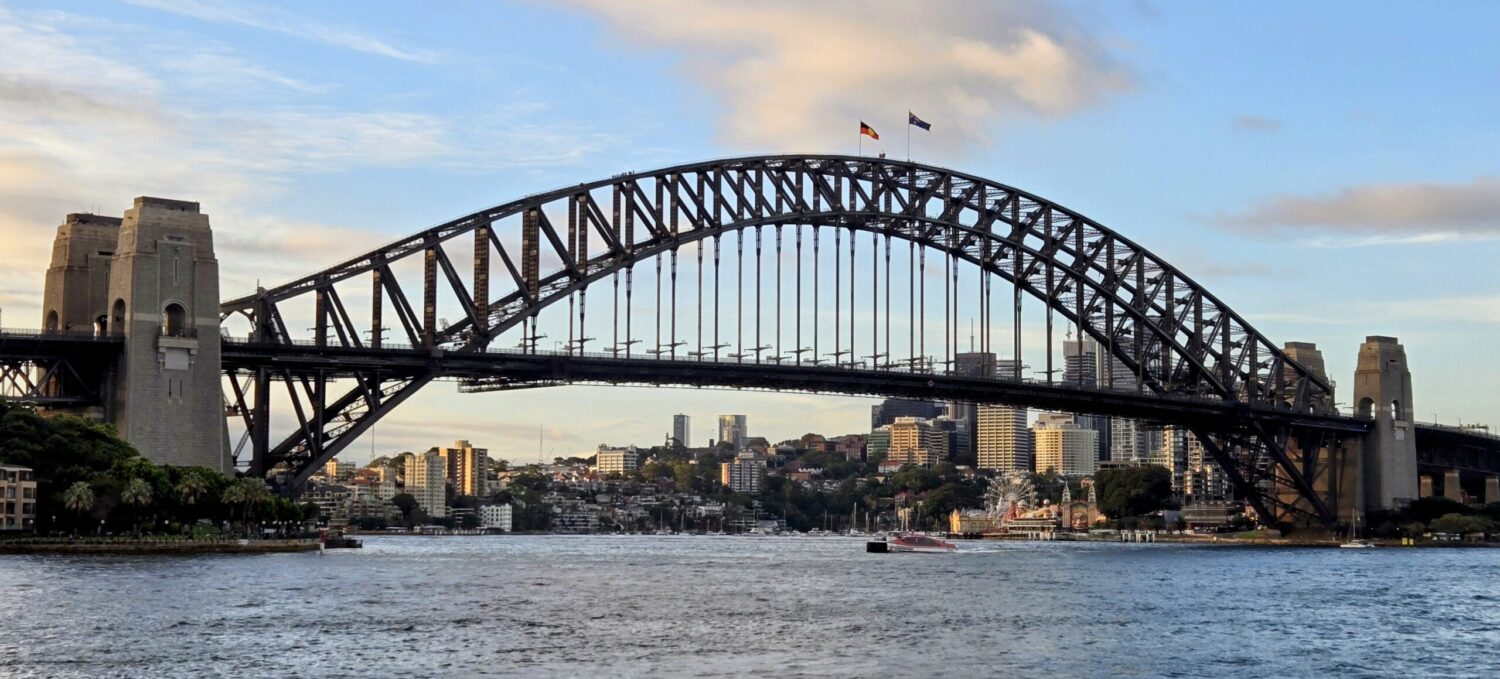Our first overnight stop on the way to Stanthorpe was at Grandchester. On a previous visit we had stayed a night at Spicers Hidden Vale. This time the resort had priced itself out of the market as far as we were concerned! So a Rustic cottage on St Benedict’s Estate it was. Three kilometres south of the one-pub-and-one-historic-railway-station town of Grandchester.

Complete with three decks, this two bedroom historic dwelling set in a large estate came with superb views all round – even from the bedroom, the bathroom and the shower.


The huge living room was fitted with an overhead projector and wind-down screen for watching TV and movies. But the complexity of just getting the screen lowered foxed us! We are easily foxed by technology! Anyway, we hadn’t come all this way to watch questionable quality televisual transmissions. An evening on the front deck watching the night sky scattered with a million stars was more our thing. Sadly, an almost full moon meant the nocturnal celestial display was not at its best. I’m always surprised to see the constellation Orion so prominent in the southern skies. This, after all, is one of the most obvious star formations in the northern hemisphere. Our peaceful evening was shared with the local fauna. A bullock appeared out of the gloom …

… while tree frogs stared down at us from the rafters.

In the morning, our equine neighbour came for her share of the apple peelings from breakfast! …

… while the kangaroos and wallabys hopped around, although mainly through the undergrowth.

Spicers Hidden Vale was just three kilometres down the road. We decided that, having saved a small fortune by not staying there, we would splash out on their breakfast! This allowed us to have a sticky beak at the place to remind ourselves of the fabulous outlook over Mount Mort (which, it was explained to us, was actually the flat green plain in front of us! Not a mountain at all!) The Great Dividing Range is visible in the distance.

What a handsome chap! And, for no other reason than this is the furthest south we have seen cotton growing, and I have a picture of it, I have included it here!

Totally unusually, almost uniquely even, I took not a single photo of our time at Stanthorpe. Sorry Beryl and John! We visited Suttons apple juice factory. The half apple pie we came away with fed four of us for two meals and still we came away with more than enough for our pudding on the way home! To say it was ginormous would be an underestimate!

That’s not actually our pie – or my photo of it – but it was the same size! Thank you Ros!
It was great to catch up with Beryl and John. Two John’s went walking by the stream which was running a little swiftly, but nowhere near what it was a couple of weeks later (as seen in the photo sent by Beryl. She thought there would be surfers on the standing waves if the flow increased any further!)

We decided to break the journey home with a night at the EcoRidge Hideaway Cottages at Preston – fifteen or sixteen minutes to the SE of Toowoomba.

Another delightful place with a fabulous view; this one run by Greg and Sylvie.


There are swamp wallabys on the property. This may or may not be one. But for us, it was!

BBQed salmon was supper that night. Bought in a poissonière in Toowoomba’s central shopping mall.

We were offered a three kilometre walk around the property. But, as the path descended to the bottom of the hill in front of us before climbing back up again, we decided a nice glass of merlot was preferable. Distinctly so!
The next day, crossing the flood-prone area around Gatton, we saw a lot more evidence of massive water movements following Cyclone Alfred. Vegetation flattened by the strength of the flow. Bits of road washed away. Kitchen sinks lodged high up in the branches of river-side trees. That sort of thing.


And look what the tide brought in at the Criterion Inn at Helidon, just to the west of Gatton! My best guess is that is a 1955 Dodge Fargo Panel Van by Chrysler. Allegedly also known as a Dodge PUB055 – and that’s the rego on this vehicle!

There was a bad coffee decision made in Helidon. One of us wanted to stop for a couple of cappucini, the other was less keen – admittedly for no particularly good or, subsequently, defensible reason! So instead of sitting down to coffees, we spent half an hour on a detour into Gatton to look for the coffee shop attached to the Queensland Transport Museum. As Glenda will tell you, I do make erroneous decisions occasionally! (Expect that to say “often” or even “usually” by the time you read this!)
By the way, as an aside, did you know the origin of the word cappuccino? I didn’t, so I checked. Mr Google informs me that the ‘Cappuccino’ takes its name from the Capuchin friars. The color of the espresso mixed with frothed milk was similar to the color of the Capuchin robe. The Capuchin friars are members of the larger Franciscan orders of monks. Their order was founded in the 16th century in Italy.
Talking of cafés, we haven’t yet had a discussion about their opening hours – or more specifically, their closing times. If you go looking for a cup of coffee or tea at anything after 3 o’clock, generally speaking you can forget it! This came into sharp focus when we arrived in Toogoolawah, north of Esk. Another delightful, well kept country town. The old Nestlé condensery is almost the first thing facing you when you turn off the “highway”.

This was where, presumably, Mr Nestlé condensed his milk before selling it in a form that could be canned and stored for years. Actually, the project was started by two local lads who had too much milk on their hands. Messrs McConnel and Munro. They sold the business to the nattily named “Nestlé and Anglo-Swiss Condensed Milk Company of Australasia” in 1907.
Anyway, where was I? Oh yes, back to café availability…
But before that … for the record, in the process of condensation, raw milk is clarified and heated to 85–90 °C for several seconds. This heating destroys some microorganisms and inhibits oxidation. Water is evaporated from the milk and sugar is added. The sugar extends the shelf life of sweetened condensed milk. Sucrose increases the liquid’s osmotic pressure, which prevents microorganism growth. The sweetened evaporated milk is cooled and canned.
After a visit to the rather fascinating art display at the rebuilt (following it being burnt-down), renovated and now re purposed factory, we headed into town for a coffee. We found the “Have a Chat Café ” on the main drag.
It was 2.15 pm. And the café is scheduled to close at 2.30 pm! But the place was already closed up as tight as a miser’s wallet. AND … the staff were already out on the street waiting for going home time! This proved to be 2.29 and 55 seconds!

Maybe 2.30 pm closing is a bit of an extreme case, but many, if not most, Australian coffee shops are firmly SHUT by 3.00 pm. Just when one is dying for a hot drink of tea.
However, in a garden up a side street, we found a couple who had recently started a coffee emporium in a tiny trailery-caravanny thing. “Snowdunder Snow Cones and Barrista”. On Fulham Street. It came with all the bells and whistles!

Their plan was to be open when needed for the supply of a latte or a cappuccino or an iced coffee and to stay open until not needed any more. We spent a happy hour drinking coffees in their company. We got a good chunk of their life history before we had to get back on the road. Their geographical and employment histories. Their family history and a near introduction to their son who we passed on the street making his way home from school. All very typical of Australian country towns!
By the way, the OED claims that the term “bells and whistles” originally comes from the practice of large organs having bells and whistles. Some large organs certainly did have bells and whistles, most notably in the silent film era when they were expected to provide sound effects to what was happening on screen. Just thought I’d mention that.
Oh, and on the café thing I feel, reluctantly, I have to acknowledge that some of them do open at 5.30 am and most by 7.00. So by 3 o’clock the barristas have been on the go for at least eight hours already.
But I still think 4 o’clock is tea time!

I agree with your timing re coffee.
Unfortunately for the surfers no standing wave appeared. Excellent outcome for people who live on the creek . No flooding and that is a very good thing.
Spicers –
We stayed there during Covid madness and while expensive not ridiculous. I think that was our one and only.
Lovely that you saw frogs and not cane toads.
Looks brilliant! Have a fab time x